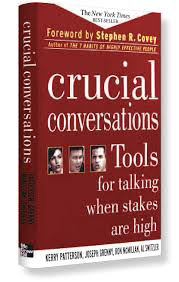Part of the Casswiki article series Books

Crucial Conversations: Tools for Talking When Stakes Are High is a business self-help book by Kerry Patterson, Joseph Grenny, Ron McMillan, and Al Switzler, first published in 2002, which describes how to interact with others in a constructive way when “stakes are high, opinions vary, and emotions run strong”.
The authors defines “crucial conversations” as conversations between two or more people that becomes crucial when opinions differ, stakes are high, and emotions run strong. And, the more crucial the conversations, the less likely we would handle it due to the fact that “countless generations of genetic shaping drive humans to handle crucial conversations with flying fists and fleet feet, not intelligent persuasion and gentle attentiveness”.[1] When a crucial conversation failed, every aspect of our lives can be affected from our personal health to our professional careers in an unhealthy or disastrous way. As we master crucial conversations, we can navigate through dangerous waters safety and effectively.
The book also touches on two most common patterns we fall into that put safety at risk when facing a crucial conversation: silence and violence (most commonly known as “fight or flight” response). With silence, we withdraw from the conversation, avoid topics or respond in ways that obscure meaning. With violence, we resort to verbal abuse, labeling, and manipulating the situation. Either way, we get “stuck” (an inability to solve problems or achieve goals) and become blind to the dialogue option.
The dialogue is the free flow of meaning between two or more people, and in a context of crucial conversations, it is the “Pool of Shared Meaning”, where facts, opinions, experiences, and feelings held by two or more people in a conversation that are understood and appreciated by all. It is a beginning of synergy.[2] In order to move to dialogue, we would need to get “unstuck” from either silence or violence by identifying where we are stuck and by looking at three parts of a problem: content, pattern, and relationship.
The book goes further on working on the self or “Work On Me First” (“Start with the Heart” - what do you really want, “Master My Stories” - we change our narrative to influence our emotions), establishing own meaning (“State My Path”) and their meaning (“Learn to Look”, “Make it Safe”, “Explore Others’ Path”), and moving to action (determining “Who does What by When” and setting “Follow-up” time - holding people accountable to their promises).
This is a practical book on basic and essential skills and mastering of difficult in-person conversations. It can be read along with How to Win Friends and Influence People and Miss Manners - all of which helps one exercises external considering.
External links
- Cassiopaea Forum: Crucial Conversations - Tools for Talking When Stakes Are High
- Cassiopaea Forum: External Considering and Good Manners
- WikiSummaries: Crucial Conversations
- VitalSmarts (corporate training and leadership development)
- YouTube: Crucial Conversations | Joseph Grenny
- YouTube: Mastering The Art of Crucial Conversations | Joseph Grenny
